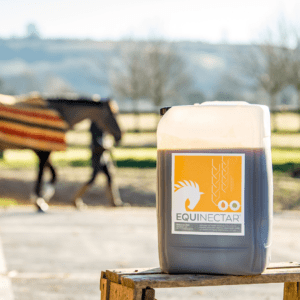

Ben Nedas
Chief Commercial Officer
Haylage for Horses: An In-Depth Guide
01
What is Haylage?
Haylage is a specially prepared forage with a high dry matter content of over 40%, making it a preferred choice for horses as well as various farm livestock. Its production focuses on achieving a minimal dry matter content to ensure a lower reliance on fermentation for preservation, thus minimising the risk of Clostridia contamination. With a pH often higher than 5.0, well-preserved haylage lacks the strong silage smell typical of lower dry matter silages. The key to maintaining its quality lies in excluding air to preserve the anaerobic conditions, as exposure to air can rapidly degrade high dry matter materials.
Grass crops intended for haylage are typically left to wilt for up to three days, reaching a dry matter content of 60% or more. This process not only ensures nutritious forage for competition horses by reducing the need for high-concentrate feeding but also promotes gut health and cost-efficiency. Haylage's dust-free nature, a result of at least six layers of quality stretch film wrapping, is crucial for horses susceptible to respiratory issues and botulism, highlighting its preference over traditional hay in equestrian care.
02
Differences Between Hay and Haylage
Hay and haylage differ primarily in their preservation methods, nutritional value, and moisture content. Haylage, cut at a younger growth stage and preserved through fermentation, retains a higher moisture content and is wrapped to exclude oxygen. This contrasts with hay, which is air-dried and requires a long period of dry weather for proper dehydration. The resulting nutritional differences might be significant; haylage can often offer a more digestible, higher energy content suitable for horses with greater dietary needs, whereas hay, can be lower in nutrients and might be for horses requiring a lower calorie intake. These are general observations, and the precise date and time of day of harvesting have a significant bearing on the nutrient values of both hay and haylage.
03
Types of Grass Within Haylage
Forages are differentiated into meadow or seed hay/haylage based on their source. Meadow forages come from permanent pastures and include a variety of grass species, whereas seed forages are cultivated from specific grass types like ryegrass and timothy, providing a more consistent product due to their targeted cultivation.
04
Benefits of Haylage
- Higher Moisture Content: Compared to hay, haylage has a significantly higher moisture content, which helps in reducing dust and potentially increasing the levels of proteins and energy.
- Dust-Free: The moisture in haylage binds any potentially harmful spores, making it an excellent choice for horses with respiratory issues or allergies, as it minimises inhalation risks.
- Nutrient-Rich: Haylage often contains higher levels of nutrients compared to hay, as it is commonly harvested earlier than hay, providing a richer source of energy and protein which is beneficial for horses in regular work, young horses, and older horses requiring easily digestible forage. If haylage is cut at the same time as hay, it should have a similar energy and nutrient profile.
- Digestibility: Due to its preparation process and moisture content, haylage is generally more digestible than hay, allowing for better nutrient absorption and utilisation.
- Cost-Efficiency: Although initially more expensive, the higher digestibility of haylage can mean less supplementary feed is needed, potentially lowering overall feeding costs.
- Suitable for a Range of Horses: From performance horses to those in light work, haylage's versatility makes it a suitable forage choice across various equine needs.
05
Disadvantages of Haylage
- Potential Weight Gain: The higher digestible energy content in early cut haylage can lead to weight gain in horses, making it less ideal for overweight horses or those prone to obesity.
- Ryegrass Issues: Haylage that contains a high proportion of ryegrass may be too rich in sugars and less digestible for some horses, potentially exacerbating conditions such as laminitis.
- Acidity and Hindgut Disturbances: Haylage that is too rich or too acidic can disrupt the hindgut's delicate balance, leading to disturbances such as colic or laminitis. The acidic environment can also affect horses with gastric ulcers or hindgut sensitivities.
- Nutritional Variability: Given its fermentation process and the variety of grasses used, haylage can vary in nutritional content, requiring careful selection to match the specific needs of a horse.
- Shorter Shelf Life: Once opened, haylage does not last as long as hay, requiring careful management to ensure it is consumed before spoiling.
- Risk of Spoilage: Improperly sealed or damaged bales can spoil due to oxygen exposure, posing health risks to horses.
- Dental Health Concerns: The acidic nature of some haylage, combined with its wet consistency, may contribute to an increased risk of dental problems over time.
06
Is EquiNectar Useful for My Horse?
For horses on a haylage-based diet, particularly those consuming ryegrass-rich varieties, balancing the diet to mitigate potential digestive issues is crucial. EquiNectar, providing essential digestive enzymes, can aid in efficiently breaking down starch and fructans in the small intestine, preventing undigested nutrients from causing imbalances in the hindgut. This can be especially beneficial for horses susceptible to the rich nutrient profile of haylage, supporting optimal nutrient absorption and maintaining digestive health.
In summary, while haylage offers considerable benefits for equine nutrition and health, understanding its potential disadvantages, particularly with ryegrass-heavy varieties, is essential for ensuring the well-being of horses. Thoughtful management, alongside supplements like EquiNectar, can help optimise the advantages of haylage in the equine diet.
ABOUT EQUINECTAR
Description
EquiNectar® is a natural feed supplement, that is scientifically proven to:
- Re-balance your horse’s gut bacteria
- Help your horse maximise benefits from its feed
- Improve your horse’s condition
More information
EquiNectar® is produced by Tharos Ltd in the UK. It is a natural source of digestive enzymes and contains only the following ingredients:
- Our patented enzyme rich malt extract
- Medium chain triglycerides (from coconut oil)
- Potassium sorbate
For more details of the enzymes within EquiNectar® take a look at the ingredients and enzymes page.
How to feed
Simply add EquiNectar® to your horse's daily feed, using the Feeding Rate chart to determine the correct amount.
For detailed instructions about how to introduce EquiNectar, please read the comprehensive Feeding Guide page.





